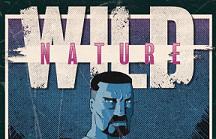Wild Nature Vol. 1 starts with – as promised by the subtitle – a goddamn bloodbath!
Blood spurts from a katana that slashes through a masked figure’s yellow and black suit. A bullet rips through another’s head, shattering their helmet and skull in a bright red burst. A team of five figures – each masked in a different animal head and armed with pistols and swords – ruthlessly hunt down and corner the last survivors. Drones buzz above, catching each kill from an optimal, unobstructed angle. Dehumanized killing, desperation, destructiveness, and therefore—a goddamn bloodbath indeed.
This is Wild Nature, a popular televised 5v5 deathmatch. In fact, it is regarded as the most popular sport in post-apocalyptic Miami. Think The Purge, complete with its creepy masked figures, but run by the NFL. Death matches replace mundane ball throwing and tackling. Commentators debate each team’s tactics to literally eliminate the other side. Fans cheer on their favorite killers. Everyone on the stands clamor over weapons and suits instead of victory rings and signed jerseys!
If the concept sounds familiar, it’s probably because you’ve seen it before: a dark dystopian setting; televised fights to the death; a tortured protagonist. There are millions of crossovers that can approximate Wild Nature’s basic concept. For example, Battle Royale’s claustrophobic brutality meets The Boys’s gritty corporate hellscape. There’s also The Hunger Games crossed with Looper, or any of the many films driven by a brooding, bloodthirsty male protagonist. However, none of these mentioned above manages to truly capture what Wild Nature accomplishes in its ferocious first volume.
Writer and artist David Taylor distinguishes Wild Nature in this crowded field. He has meticulous attention to worldbuilding, intriguing characters, and a distinctively sharp art style. With all that, he carefully avoids the pitfalls of cliché. The vivid and moody art style also ties the characterization and worldbuilding into a cohesive, memorable bundle. Taylor infuses each frame with shadows and a dark and gloomy palette.
Wild Nature takes place in a future Miami that has suffered through numerous pandemics. And here we thought COVID-19 was bad enough! There are riots and economic collapse. Our protagonist is one of the best fighters Wild Nature has ever seen; Cy Swan is pretty much the Tom Brady or Peyton Manning of the sport. His signature tagline – firmly engraved into his psyche after a lifetime of murder, which won him fame, wealth, and legions of fans – is: “Always be killing”.
The disillusioned Swan has retired from Wild Nature, determined to find a purpose other than killing. As the comic progresses, Swan finds himself caught between suffering an “attack of the principles” – as his close friend and business partner, Jack Ophidian, puts it – and his own “wild nature”. This manifests into black and red thought bubbles that haunt him at every frame. The comic appropriates a newspaper strip that’s been left in the light for too long. Angular characters blend into the background, their eyes glowing in the darkness of each frame. Streets and buildings feel dirty, off-color, even claustrophobic.
Regardless, Taylor knows how to make key moments pop. He uses his grimy color palette to give each sequence a unique and cohesive aesthetic. For instance, a tense, sickly red coats a particularly memorable showdown between two Wild Nature teams, emphasizing the sheer brutality of the “sport”. Overall, Swan’s world is distinctly oppressive, which fits for a future – and man – scarred by destruction and collapse. Harsh lighting; cold color scheme; black text boxes representing Swan’s darkest thoughts that intrudes on nearly every frame. All of these well and truly mirror Swan’s own disturbed mental state.
Taylor’s worldbuilding considers the specifics; he has an ability to infuse lines or images with key information about Wild Nature’s society. Scenes, for instance, are interspersed with a peek into corporate dystopia via a series of worn and torn marketing flyers: a youth program sponsored by Wild Nature; an intimidating security force called the “Blackhawks”; retrowave-esque posters advertising “Magic City Miami”. These are some of the more believable in-world artifacts I’ve seen in a comic. And they go a long way towards making the lore and world memorable.
Overall, Wild Nature Vol. 1 is an effective setup for an intriguing, though familiar, world. The characters introduced all have the seeds of interesting plots. Aside from Swan’s conflicted conscience, the most promising ones are the mounting pressure on Ophidian to find investors for Wild Nature, as well as a woman named Alice’s desire to take revenge on Swan after he murdered her family member in a Wild Nature bout.
It’s a wonder whether Taylor will continue to balance the fine, tricky line between cliché and originality in future volumes. Given the interesting narrative roots he has created so far, I’m optimistic. After reading Vol. 1, it’s easy to look forward to returning to this gritty, vicious world. In conclusion, I anticipate to see wherever Taylor brings the narrative of this carefully constructed world.
Have you read Wild Nature Vol. 1? If you are and are also looking forward to Vol. 2, you can find all the purchase info on both here. If you have any thoughts, feel free to sound off in the comments or send us a line on Facebook or Twitter!

